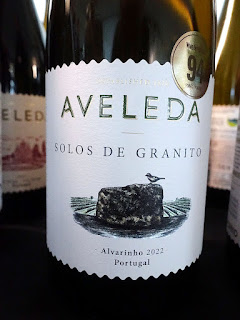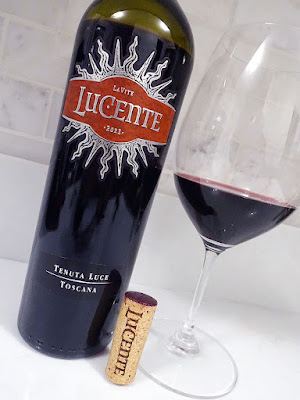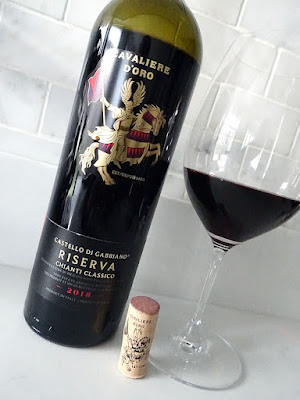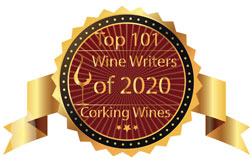Here are my top wine picks from the March 15, 2025 LCBO VINTAGES New Release Collection, which features Sustainable Italian Wines as the main theme of the release, while the mini-theme looks at Stellar Stellenbosch. The release as a whole is very good with ninety-four products on offer at various price points, with all but ten coming in at $40 or less. Also included in this release are nearly a dozen Online & Flagship Exclusives (OFE) wines. All the wines should be available for purchase by Saturday, if not already on shelves (and online) today.
We'll begin with the feature story of the release - Sustainable Italian Wines - where a dozen wines are included as part of the theme and five are among my top wine picks. The two sustainably crafted white wines are a Verdicchio from Marche, and a Grillo from Sicily. The mono-varietal sustainable red wines are the Nero d'Avola from Sicily, and the Chianti Classico, which is made with 100% Sangiovese. The Rosso di Montepulciano from Tuscany is a blend of 80% Sangiovese and 20% Merlot.
The "mini-theme" is a very, very brief look at wines from Stellenbosch, South Africa. There are only(!) three wines included in the thematic, and my only pick from this group is the Syrah. Why limit the mini-theme to a very slim count of just three wines? I would recommend that mini-thematics should include anywhere from 6 to 8 wines.
Among my top red wine recommendations from the main release, we'll begin with the blends from Iberia, with the Bierzo from Spain consisting of 85% Mencía, 10% white grapes, and 5% other red varieties, while the Alentejano from Portugal is crafted with Trincadeira, Aragonez, Touriga Nacional, and Syrah. The only other red blend is from Roussillon, and it is composed of Grenache, Carignan, and Syrah. Among the single varietal wines, there is an excellent Brunello di Montalcino that is crafted with Sangiovese, while the wine from Castilla y León is 100% Tempranillo. The lovely wine from Greece is Xinomavro, and the Chilean red is Carmenère. On the local front, there are a couple of fine Pinot Noirs from the Bench in the Niagara Escarpment, as well as a Gamay from the Niagara Peninsula.
All of my white wine picks from the rest of the release are mono-varietal wines, with a trio of Chardonnays leading the pack. There are two Chardonnays from Niagara, as well as one from South Africa. For other dry whites, you can go slightly off the beaten path with a fine Ribolla Gialla from Friuli, or the elevated Alvarinho from Vinho Verde. There's also a fine Sauvignon Blanc from Niagara, along with a dry Pinot Gris from New Zealand. If you want a wine with a little sweetness, check out the lovely Niagara Riesling.
Lastly, there is a lovely, fortified wine from Portugal that is very sweet, but balanced, and crafted using the Setubal Moscatel variety, which is also known as Alexandria.
Enjoy my top wine recommendations from this release! Cincin!
We'll begin with the feature story of the release - Sustainable Italian Wines - where a dozen wines are included as part of the theme and five are among my top wine picks. The two sustainably crafted white wines are a Verdicchio from Marche, and a Grillo from Sicily. The mono-varietal sustainable red wines are the Nero d'Avola from Sicily, and the Chianti Classico, which is made with 100% Sangiovese. The Rosso di Montepulciano from Tuscany is a blend of 80% Sangiovese and 20% Merlot.
The "mini-theme" is a very, very brief look at wines from Stellenbosch, South Africa. There are only(!) three wines included in the thematic, and my only pick from this group is the Syrah. Why limit the mini-theme to a very slim count of just three wines? I would recommend that mini-thematics should include anywhere from 6 to 8 wines.
Among my top red wine recommendations from the main release, we'll begin with the blends from Iberia, with the Bierzo from Spain consisting of 85% Mencía, 10% white grapes, and 5% other red varieties, while the Alentejano from Portugal is crafted with Trincadeira, Aragonez, Touriga Nacional, and Syrah. The only other red blend is from Roussillon, and it is composed of Grenache, Carignan, and Syrah. Among the single varietal wines, there is an excellent Brunello di Montalcino that is crafted with Sangiovese, while the wine from Castilla y León is 100% Tempranillo. The lovely wine from Greece is Xinomavro, and the Chilean red is Carmenère. On the local front, there are a couple of fine Pinot Noirs from the Bench in the Niagara Escarpment, as well as a Gamay from the Niagara Peninsula.
All of my white wine picks from the rest of the release are mono-varietal wines, with a trio of Chardonnays leading the pack. There are two Chardonnays from Niagara, as well as one from South Africa. For other dry whites, you can go slightly off the beaten path with a fine Ribolla Gialla from Friuli, or the elevated Alvarinho from Vinho Verde. There's also a fine Sauvignon Blanc from Niagara, along with a dry Pinot Gris from New Zealand. If you want a wine with a little sweetness, check out the lovely Niagara Riesling.
Lastly, there is a lovely, fortified wine from Portugal that is very sweet, but balanced, and crafted using the Setubal Moscatel variety, which is also known as Alexandria.
Enjoy my top wine recommendations from this release! Cincin!
Red Wine:
- FLOR DE MAIO MAYFLOWER 2021 - Vegan, Vinho Regional Alentejano, Portugal (#427195) (XD) - $15.95 89 pts wine review
- GORGHI TONDI COSTE A PREOLA NERO D'AVOLA 2022 - DOC Sicilia, Italy (#39219) (XD) - $17.95 90 pts wine review
- FEATHERSTONE GAMAY NOIR 2021 - Vegan, VQA Niagara Peninsula, Ontario, Canada (#39275) (XD) - $18.95 89 pts wine review
- GLENELLY GLASS COLLECTION SYRAH 2021 - WO Stellenbosch, South Africa (#493841) (XD) - $19.95
- CHÂTEAU SAINT-ROCH CHIMÈRES GRENACHE / CARIGNAN / SYRAH CÔTES DU ROUSSILLON-VILLAGES 2022 - AP, Midi, France (#119354) (XD) - $19.95
- SAN PEDRO 1865 SELECTED VINEYARDS CARMENÈRE 2022 - Las Lagunas, DO Valle de Colchagua, Chile (#249201) (XD) - $20.95 90 pts wine review
- BOUTARI NAOUSSA XINOMAVRO 2021 - PDO Naoussa, Macedonia, Greece (#23218) (XD) - $20.95 90 pts wine review
- ALEJANDRO FERNÁNDEZ DEHESA LA GRANJA 2018 - Vino de la Tierra de Castilla y León, Spain (#192476) (XD) - $22.95 91+ pts wine review
- POLIZIANO ROSSO DI MONTEPULCIANO 2022 - DOC, Tuscany, Italy (#22795) (XD) - $24.95
- RICASOLI BROLIO BETTINO CHIANTI CLASSICO 2021 - Sustainable, DOCG, Tuscany, Italy (#630939) (XD) - $27.95
- DESCENDIENTES DE J. PALACIOS PÉTALOS 2022 - DO Bierzo, Spain (#446484) (XD) - $29.95
- THIRTY BENCH SMALL LOT PINOT NOIR 2021 - Sustainable, VQA Beamsville Bench, Niagara Escarpment, Ontario, Canada (#44041) (XD) - $40.00 92 pts wine review
- BACHELDER WISMER-PARKE SINGLE VINEYARD PINOT NOIR 2022 - VQA Twenty Mile Bench, Niagara Escarpment, Ontario, Canada (#520379) (XD) - $54.95 OFE
- IL POGGIONE BRUNELLO DI MONTALCINO 2019 - DOCG, Tuscany, Italy (#551176) (XD) - $76.95 93 pts wine review
White Wine:
- CASAL DI SERRA VERDICCHIO DEI CASTELLI DI JESI CLASSICO SUPERIORE 2023 - Sustainable, DOC, Marche, Italy (#268169) (XD) - $18.95 88+ pts wine review
- TE PA PA ROAD MARLBOROUGH PINOT GRIS 2024 - Sustainable, Vegan, Marlborough, South Island, New Zealand (#41804) (XD) - $18.95
- PLANETA LA SEGRETA GRILLO 2023 - Sustainable, DOC Sicilia, Italy (#39442) (XD) - $19.95 90+ pts wine review
- TRIUS DISTINCTION SAUVIGNON BLANC 2022 - VQA Niagara Peninsula, Ontario, Canada (#19379) (XD) - $19.95
- AGANIS DI FLABE RIBOLLA GIALLA 2023 - DOC Colli Orientali del Friuli, Italy (#39744) (XD) - $22.95 90+ pts wine review
- AVELEDA SOLOS DE GRANITO ALVARINHO 2022 - Vegan, DOC Vinho Verde, Portugal (#17514) (XD) - $24.95 91 pts wine review
- HIDDEN BENCH ESTATE RIESLING 2020 - VQA Beamsville Bench, Niagara Escarpment, Ontario, Canada (#183491) (D) - $24.95
- LE CLOS JORDANNE JORDAN VILLAGE CHARDONNAY 2021 - VQA Niagara Peninsula, Ontario, Canada (#20455) (XD) - $30.00 90+ pts wine review
- BACHELDER LES VILLAGES BENCH CHARDONNAY 2022 - VQA Niagara Escarpment, Ontario, Canada (#16059) (XD) - $34.95 OFE 91+ pts wine review
- TESSELAARSDAL CHARDONNAY 2023 - Vegan, WO Hemel-en-Aarde Ridge, South Africa (#32933) (XD) - $49.95 OFE
Fortified Wine:
- VENÂNCIO COSTA LIMA MOSCATEL DE SETÚBAL 2021 - DOC, Portugal (#42991) (S) - $18.95 91 pts wine review


































